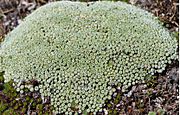Pterygopappus facts for kids
Quick facts for kids Sage cushion plant |
|
|---|---|
 |
|
| Pterygopappus lawrencii | |
| Scientific classification | |
| Kingdom: | |
| (unranked): | |
| (unranked): | |
| (unranked): | |
| Order: | |
| Family: | |
| Tribe: |
Gnaphalieae
|
| Genus: |
Pterygopappus
|
| Binomial name | |
| Pterygopappus lawrencii |
|
| Synonyms | |
|
Gnaphalium sect. Pterygopappus (Hook.f.) Baill. Pterygopappus lawrencei Hook.f., alternate spelling |
|
Pterygopappus is a type of flowering plant. It belongs to the daisy family. There is only one known kind of this plant, called Pterygopappus lawrencii. It is also known as the Sage cushion plant. This special plant only grows in the high mountains of Tasmania, Australia. It forms thick, soft mats that are light blue-green. Its leaves are packed very close together. You can find it mostly in the mountains of northeastern Tasmania. It grows slowly and likes cool, damp places.
Contents
What Does the Sage Cushion Plant Look Like?
The Sage cushion plant, or P. lawrencei, grows in a noticeable tufted shape. It is easy to spot because of its sage-green leaves. These leaves are very small, usually less than 5 millimeters long. They are packed together so tightly that they can look like a tiny cabbage or a rose. The leaves are covered in very fine, white hairs.
Underneath these tightly grouped leaves, stems grow longer. New leaves are produced at the same rate. This makes it hard to tell which leaves are connected to which stem. This is how the plant spreads across the mountain landscape. From the middle of the small "rosette" of leaves, a small, white, daisy-like flower appears. This happens between December and March. The plant's fruit is called an achene, which is a small, dry fruit.
Where Does This Plant Live?
P. lawrencei lives in tough mountain areas. You can find it in high-altitude heathlands, alpine plant areas, and wet, rocky slopes. It grows mostly in eastern Tasmania. This includes places like the Central Plateau, Mount Field National Park, and Cradle Mountain National Park. The places where this plant lives show how tough it is.
It prefers thin, peaty soil. This soil is made from rocks like dolerite that have been worn down by ice and weather. The plant is also always exposed to strong winds, snow, and very cold temperatures. It is rare to find a patch of P. lawrencei growing all by itself. These plants usually grow mixed in with other cushion plant species. Some examples are Donatia novae-zelandiae, Dracophyllum minimum, Abrotanella forsteroides, and Schizacme archeri.
This ability to grow very close to and even mix with other cushion plants helps them survive. Their tightly packed leaves help keep the center of the plant at a steady temperature. Also, their low, spreading shape helps them avoid the strongest winds.
Why Is This Plant Important?
The Sage cushion plant is very important for its environment. It is called an "engineering" or "foundation" species. This means it helps create and shape its habitat. For example, these plants can help form small mountain lakes (tarns) and tiny rivers in alpine areas.
Together, cushion plants help many different types of species live in these areas. They attract more kinds of animals and plants compared to areas without cushion plants. They also provide a safe place for small creatures like arthropods. Plus, their flowers offer food for insects that help with pollination.
What Harms the Sage Cushion Plant?
One big danger to mountain plants is fire. However, the Sage cushion plant can usually recover quite well from fires. A bigger problem is people walking on them. Foot traffic from bushwalkers can greatly damage these plants. This is especially true in very wet or waterlogged areas.
If a plant is damaged, it can take up to 10 years to fully recover. During this time, the soil can erode more easily. This happens because the plants are not there to hold the soil in place. Also, insects and arthropods that rely on these plants for food and shelter might decrease in these damaged areas.

